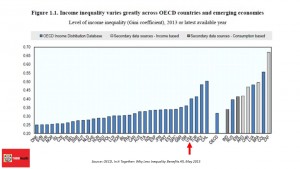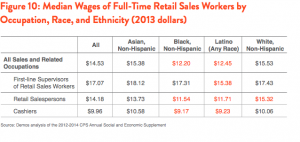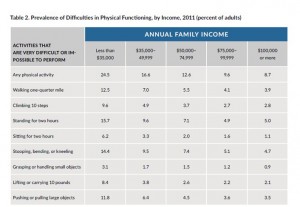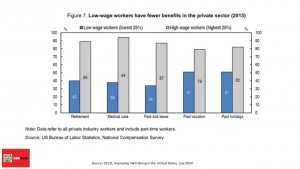 Income inequality has increased in most developed countries, and especially in the U.S., according to the OECD’s report, In It Together: Why Less Inequality Benefits All, published in May 2015.
Income inequality has increased in most developed countries, and especially in the U.S., according to the OECD’s report, In It Together: Why Less Inequality Benefits All, published in May 2015.
The red arrow in the first chart shows where the U.S. ranks versus other developed nations in income inequality, which is defined as the wealth gap between rich and poor people. The U.S. has the greatest income inequality in the developed world.
The second chart shows data for the U.S. on benefits provided to low-wage workers (the bottom 25% of wage earners) versus high-wage workers (the top 25% of earners). Low-wage workers receive lower benefits for every one of five benefit categories including retirement, medical care, paid sick leave, paid vacation, and paid holidays. These statistics come from the U.S. Bureau of Labor Statistics National Compensation Survey and include all private industry workers including part-timers.
Benefit inequality in the U.S. further exacerbates overall wealth inequality noted by OECD in their report.
Health Populi’s Hot Points: There are several examples of health inequities in the news this week that illustrate how income inequality directly and negatively impacts individual and public health.
 The retail sector has historically paid lower hourly wages to workers compared with other industries, and this week’s report from Demos and the NAACP finds a “retail race divide” for African-Americans and Latinos working in retail which is the second-largest industry for black employment in the U.S. The report documents what it terms a racial wage divide in the front-line retail salesforce.
The retail sector has historically paid lower hourly wages to workers compared with other industries, and this week’s report from Demos and the NAACP finds a “retail race divide” for African-Americans and Latinos working in retail which is the second-largest industry for black employment in the U.S. The report documents what it terms a racial wage divide in the front-line retail salesforce.
 The Urban Institute published research asking the question, How Are Income and Wealth Linked to Health and Longevity? The answer is, quite directly. In the context of Demos/NAACP report findings, the Urban Institute’s research found that while blacks and Hispanics have higher rates of disease compared with non-Hispanic whites, those differences are “dwarfed” by disparities between high- and low-income populations within each racial or ethnic group. The chart compares peoples’ ability to perform daily physical activities by annual family income: people who are lower income earners have more difficulties across all activities, such as stooping or kneeling, lifting 10 pounds, climbing 10 steps, and walking one-quarter mile. The Institute’s bottom line: “better economic conditions for American families mean longer lives and better health, and better health means lower health care costs.”
The Urban Institute published research asking the question, How Are Income and Wealth Linked to Health and Longevity? The answer is, quite directly. In the context of Demos/NAACP report findings, the Urban Institute’s research found that while blacks and Hispanics have higher rates of disease compared with non-Hispanic whites, those differences are “dwarfed” by disparities between high- and low-income populations within each racial or ethnic group. The chart compares peoples’ ability to perform daily physical activities by annual family income: people who are lower income earners have more difficulties across all activities, such as stooping or kneeling, lifting 10 pounds, climbing 10 steps, and walking one-quarter mile. The Institute’s bottom line: “better economic conditions for American families mean longer lives and better health, and better health means lower health care costs.”
Why Helping the Poor Pay for Broadband is Good for Us All in Wired talks about why the Chairman of the Federal Communications Commission, Tom Wheeler, wants to expand subsidies to low-income households to cover broadband, which would deliver Internet connectivity to their homes. “The Internet is a crucial gateway to economic opportunity,” the article continues. Historically, it was landlines that were, in the words of Congress, “crucial to full participation in our society and economy.”
For people in America with low incomes, not having Internet access isn’t about Facebooking or streaming movies on Netflix, the piece argues — it’s about access to education and employment opportunities.
The OECD published the Better Life Index today, with a blog post on The Recipe for a Better Life which combines several ingredients: income, jobs and housing, along with environment, community, work-life balance, personal security, education, health, civic engagement and the level of satisfaction with life.
The OECD has found that its nations’ citizens say a Better Life means being “healthy, happy and wise” with health at the top of the list. Lowering stark income inequality in the U.S. can help improve the nation’s health status, build more productive workers, and drive a healthier national economy.





 Thank you, Trey Rawles of @Optum, for including me on
Thank you, Trey Rawles of @Optum, for including me on  I was invited to be a Judge for the upcoming
I was invited to be a Judge for the upcoming  For the past 15 years,
For the past 15 years,